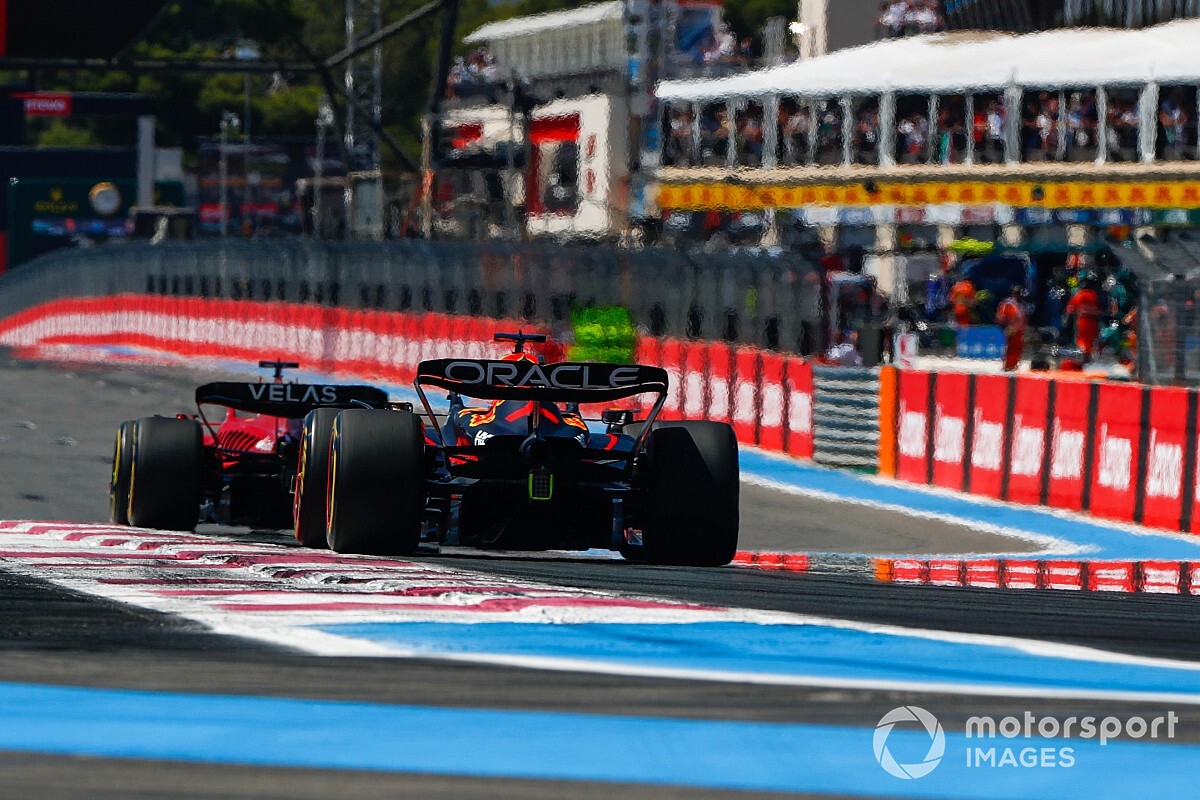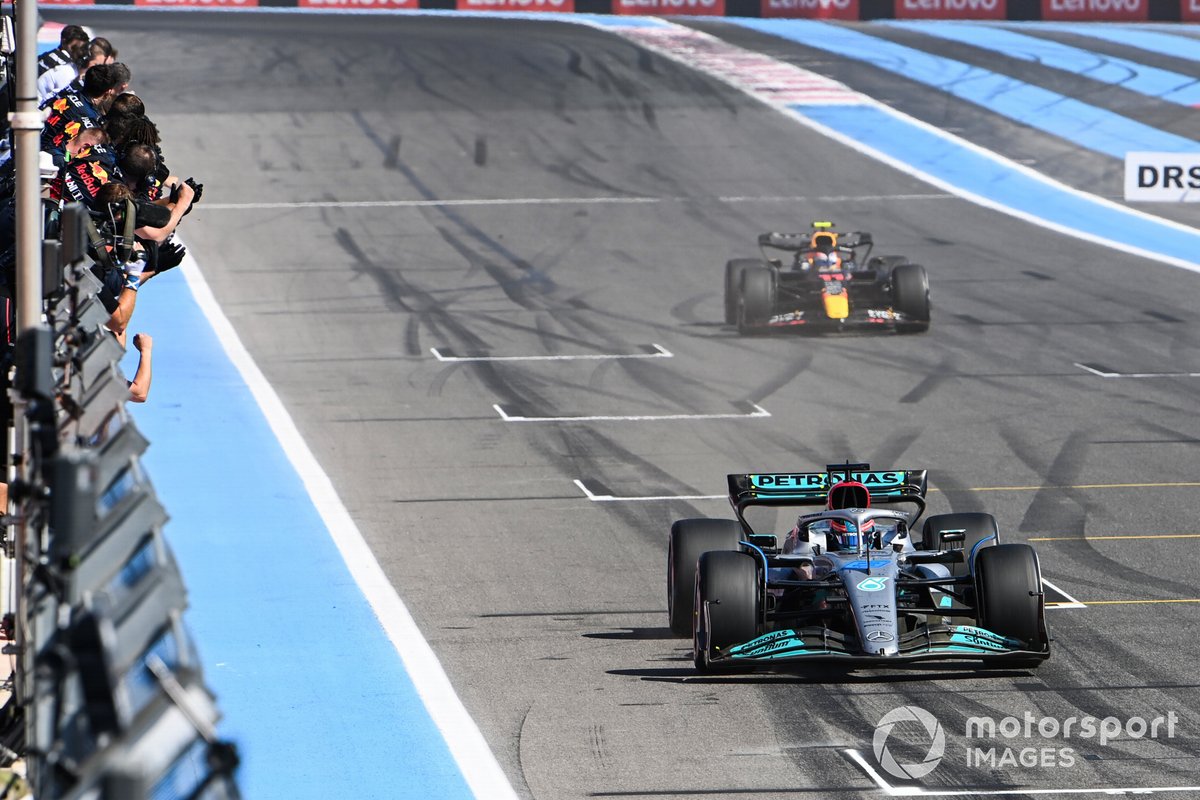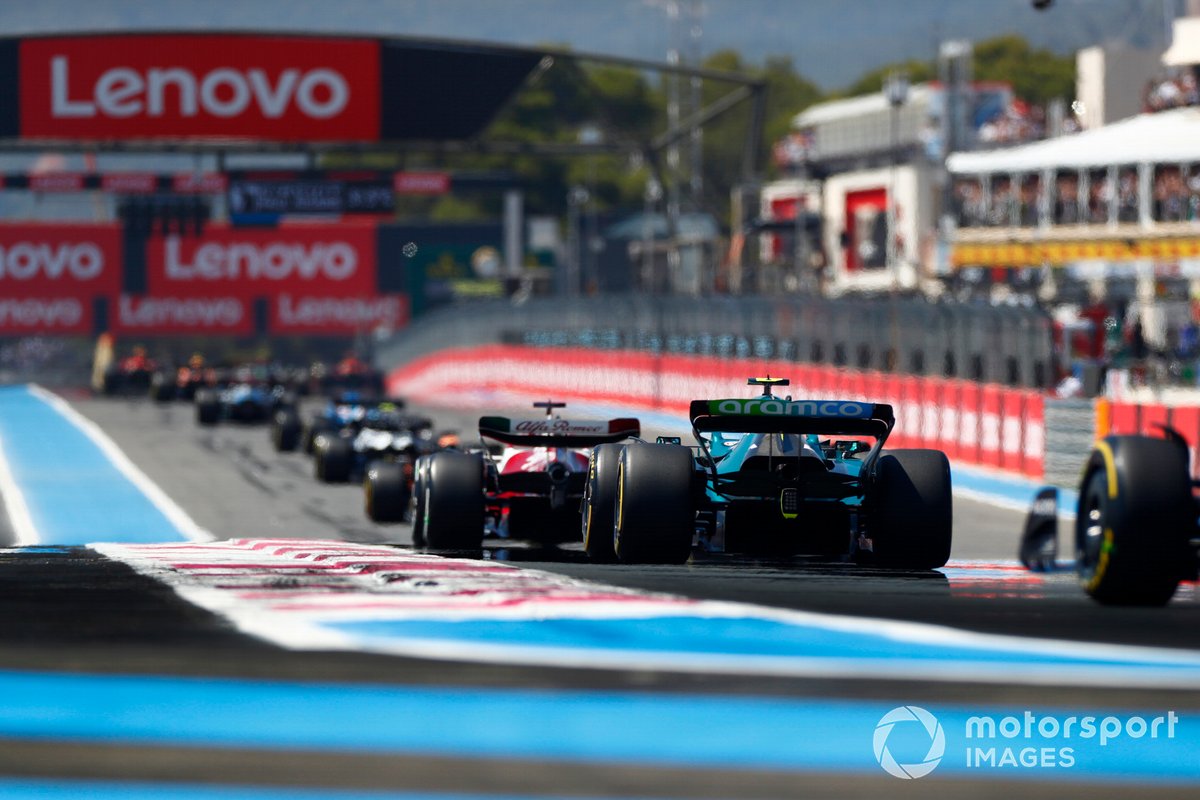
Paul Ricard might have been sweltering as the mercury climbed to 35 degrees Celsius, but from lap 19 of 53 in the French Grand Prix last Sunday, Max Verstappen barely had to break a sweat to chalk his seventh victory of the 2022 Formula 1 campaign.
While nearest title rival Charles Leclerc held track position early on after landing pole, the Austrian GP winner bottled the chance to convert it into the spoils when he spun off the road and found a barrier during his attempt to defend against a Red Bull undercut.
On a day when the gap between the two title protagonists could have dropped to 30 points, instead Verstappen heads to Hungary - the final race before the summer break - with a 63-point cushion as the red team and driver squandered another golden opportunity.
Leclerc’s demise did allow Mercedes to capitalise on its stellar reliability record to snatch a double podium, with George Russell grabbing third at the death after a strategic showdown against Sergio Perez - the Mexican enduring one of his poorest rounds this term.
Meanwhile, Carlos Sainz recovered from the back of the grid to fifth place but only after more operational questions were raised by Ferrari’s practice.
With all those storylines and more emanating from a final runout at Le Castellet, here are 10 things we learned from the 2022 French Grand Prix.

1. Leclerc must share the blame with Ferrari when these titles are lost
It’s been easy to take aim at Ferrari this season (and this list will do that soon enough!) but it is now clear that Leclerc must shoulder significant responsibility for allowing Verstappen such clear air in the race and championship battle.
The standings gap on Monday morning between the pair might have been half its current 63-point chasm had Leclerc, on degrading rear Pirellis, not lost the back end of his F1-75 on lap 18 to nose in the barriers at a time when Verstappen had pitted and was running in seventh.
In the immediate aftermath, there was some confusion over whether a sticking throttle damper - as per the closing laps at the Red Bull Ring - might have been to blame. But no, this was a driver error. Leclerc’s heavy breathing followed by his screaming: “Nooo!” over team radio will surely live long in the memory.
The Monegasque did own his error completely, taking full responsibility. But alongside spinning out of third at Imola when in pursuit of Perez, these are now two high-profile blunders. Verstappen, by contrast, has only made one: spinning at Turn 4 in Spain. However, on a day when Leclerc’s engine self-immolated, the reigning champion still won.
Here lies the crux of the issue. Ferrari’s unreliability creates fewer opportunities for Leclerc to pounce and fight for the win. But in France, he blew the chance.
PLUS: The knife-edge French GP Verstappen fight factors that led to Leclerc's costly crash
In his own words: “I think there are 32 points overall [I’ve lost with mistakes]… 25 today - I think it was likely we were going to win today because we were fast. Seven in Imola, with my mistake. So, at the end of the year we will count back. If there are 32 points missing then I know it’s coming from me and I did not deserve the championship.”

2. Verstappen, like us, is disappointed when there’s no Leclerc to battle
After Leclerc’s biff into the barriers and when Verstappen emerged ahead of Lewis Hamilton, once the Mercedes driver pitted under the safety car, the fight for the win effectively fizzled out. On another day, the heavier Red Bull RB18 running in dirty air against a Ferrari F1-75 that was chewing through its tyres would have paved the way for a thrilling climax. That spectacle was denied, and it wasn’t just spectators who missed out.
Verstappen’s race engineer Gianpiero Lambiase had this immediate reaction when his driver crossed the line for a 27th F1 win: “Well done, Max. Well closed off. Shame, I think it would have been a good race. Nevertheless, you brought it home.” Verstappen would later tell media: “It was really unlucky for Charles and I’m glad he’s OK; it could have been a really fun race because both cars were so quick!”
Red Bull team boss Christian Horner reckoned his driver had it in the bag regardless of Leclerc’s crash, particularly as he was on a powerful undercut by switching to hard tyres on lap 16 for what would be a one-stop. However, it never played out.
After Leclerc passed Verstappen fairly on track three times in Austria, Verstappen lost the chance to directly reassert himself in the wheel-to-wheel stakes. And much like Mercedes desired a closer rival for its run of 2014-21 consecutive constructors’ championship dominance, the eventual success would have been all the sweeter had Red Bull and Verstappen been made to work even harder for it in France.

3. Shrewd Sainz is now proving the more effective deputy over Perez…
It wasn’t the most convincing of starts to the season for Sainz - adrift of Leclerc in Bahrain and Saudi Arabia, spinning into the gravel in Australia, being turned around at Imola. But he now appears to have found his stride at a time when his Red Bull counterpart Perez seems to be stumbling.
Sainz’s victory at Silverstone was a touch fortunate due to questionable Ferrari strategy; his loss of a likely second place in Austria wholly unfortunate due to questionable Ferrari reliability. The legacy of the latter was starting from the back at Paul Ricard, but he surged from 19th to fourth despite the 5s penalty for an unsafe release. A podium probably went begging.
Like in the British GP at the safety car restart, it was seemingly left to Sainz again to coach the pitwall rather than vice versa when he was wrongly told of a 5s stop/go penalty and then interrupted while passing Perez. The Spaniard, despite the distractions in the cockpit, was pin sharp. And although his late switch to fresh mediums certainly helped, he had comfortably the best race pace of the whole field and snared fastest lap to boot.
PLUS: French Grand Prix Driver Ratings 2022
This came when Perez turned in the sort of performance that cost Alex Albon and Pierre Gasly the second seat at Red Bull. He was out of the pole battle for a third race in a row and had Leclerc not crashed and Sainz not penalised, would have been sixth behind the two Mercedes. While Perez himself conceded this was a bad weekend, he fell short of the top-four minimum requirement that his rear-gunner role entails.
After he bolted out of the gates well at the start of the ground-effect era, the developments to the RB18 have hurt him. Meanwhile, Sainz is on the up.

4. …but Ferrari is continuing to make mistakes that Red Bull seems immune to
Ferrari, and later Sainz, was convinced that an extra pitstop was required late on. The sole remaining F1-75 did enjoy a marked pace advantage after passing Russell and then Perez. But the Scuderia decided against keeping Sainz out to pull a 5s gap to seal a podium as tyre degradation data suggested a late slide down the order was in the offing. And despite the initial confusion, Leclerc was eliminated by driver error rather than a mechanical malady. So, Ferrari don't deserve every ounce of criticism.
However, Ferrari are still shipping plenty of time through mistakes. With Sainz out of the qualifying picture due to his engine change penalties, it was a strategic masterclass to get him to provide Leclerc with a tow to land pole. But, then at the first pitstop, the change of the rear-right was slow and then the rear jack delayed to release him into the path of Albon, who had to lock up to avoid a shunt in the pitlane. Bang to rights, the FIA swiftly dealt a 5s penalty for an unsafe release. This was then incorrectly reported to Sainz as a 5s stop/go – no such reprimand exists.
The team radio blunders continued when, give or take some delay with the TV world feed, Sainz was interrupted while attempting to pass Perez. That’s despite the pitwall having a constant onboard camera to view to know he was at best closing, at worst side-by-side with the Red Bull. Then, Sainz’s second stop ran for 9.3s. Even with the 5s penalty, another 1.5-2s bled away.
Ferrari was right to defend its strategy, having called in Sainz when he’d taken third place. But that shouldn’t mask the other blunders and rough edges that weren’t in short supply.

5. Hamilton’s latest statistical achievements shouldn’t fly under the radar
Alongside seven world championships, plus holding the record number of poles and race wins (103 apiece), a rather quiet drive to second place at a venue where Hamilton has won twice is altogether a less glossy a feat. However, he still deserves plaudits.
He beat his team-mate for a double Mercedes podium aboard a W13, that as Friday practice and the qualifying deficit underlined, remains some way off the pace. Despite that, he maximised the returns in Q3 and the race. And in the cooking temperatures, he did so without the drinks bottle.
But more than that, on his 300th grand prix start, he visited the rostrum for the 187th time. Exceeding a one in two ratio is a fearsome strike rate. That’s a 62.33% strike rate to be precise - 12% higher than Michael Schumacher, 20% over Sebastian Vettel and so on. Of those to score 10 or more podiums, there’s only one driver to have eclipsed Hamilton: five-time title winner Juan Manuel Fangio (68.63%, 35 podiums from 51 starts).
Next in the crosshairs should be Hamilton becoming the first driver to score a race win after making their 300th start…

6. George Russell is the type of guy to know the rulebook inside-out
Russell is a director of the Grand Prix Drivers’ Association, so perhaps it isn’t all that surprising to learn he’s extremely dialled in to the finer points of the regulations. Nevertheless, in the knowledge the stewards would be listening in, he vehemently argued his case for why a lunge from very far back on Perez into the chicane was perfectly legal in his eyes, as he recited the letter of the law.
The front-right wheel of the Mercedes W13 was well ahead of the rear-left wheel of the RB18 when both drivers turned in. So far alongside was Russell that the contact point was closer to the leading edge of the floor (where the bargeboards used to be). However, it is debatable whether both could have made the corner given the Silver Arrow’s overspeed.
Russell would then seemingly read the end of the virtual safety period to perfection to catch Perez napping - the FIA system having reset to trigger two restarts - to nail a fine podium.
The Brit said: “I felt it was my corner, I was down the inside, I had my front wheels in front of his rear wheels, and to the letter of the law, it was my corner, and he squeezed me a bit onto the kerb and he went wide, and kept his position… these things have a way of working themselves out, and the VSC restart was pretty tasty.”

7. Alpine evolution is paying off more handsome than McLaren revolution
A tweaked floor edge here, a revised rear wing there. Alpine appears to be modifying only a small bit of the A522 at a time. The gains are more marginal, but easier to trace and isolate than McLaren. By contrast, it has used the Spanish and now French GPs to introduce more radical, wide-ranging upgrade packages.
It seems Alpine’s potentially more cautious route is currently the more prosperous in the hunt for fourth in the constructors’ championship. After an underwhelming start to the campaign, McLaren leapfrogged to ‘best of the rest’ in the points after Australia and had stayed there until Paul Ricard. Last weekend, however, Alpine stole the march.
Fernando Alonso’s stellar run of form returned sixth ahead of Lando Norris and Alpine team-mate Esteban Ocon as Daniel Ricciardo completed the blue-and-papaya train in ninth. From being tied on 81 points pre-race, and with Alonso estimating a 0.5s deficit to the brace of MCL36s heading into the race, Alpine has now nicked the position by four points. Viva la evolution!

8. Sebastian Vettel knows what’s good for him…
There had been speculation earlier in the season that this was to be Vettel’s last season in the topflight. This came after Aston Martin’s poor start to the new ground-effect era plus the German saying on BBC Question Time that he was “asking myself” whether to continue given the difficulties in reconciling racing with his climate activism.
Then in the Thursday press conferences at Paul Ricard, for the first time, the driver went on the record with his desire to remain, saying: “I'm talking to the team; I think there is a clear intention to keep going.”
As ‘silly season’ and the summer break approach, Vettel would have significantly hurt his negotiating position if he’d wiped team-mate and team boss Lawrence Stroll’s son Lance out of a points-paying position in the final corner of the French GP. Stroll, to keep his stablemate at bay, effectively parked on the apex to fend of Vettel cutting back for a superior exit.
They avoided contact by millimetres rather than inches to complete a 10-11 result, cars intact and with Stroll deservedly claiming the bragging rights on a day when an order for Vettel to back off didn’t arrive.

9. Paul Ricard passed muster as it bids adieu
Leclerc did well to bury his Ferrari in a wall given the acres of run-off at Paul Ricard, hence its success as a testing venue where mistakes aren’t always penalised. The vast distance to the racing line ensures TV cameras are placed well back and combine with the flat scenery and genuinely unpopular layout to hamper the spectacle.
For those in attendance, traffic management has been a headache and races generally subpar at Le Castellet. All told, while a French race feels right for F1 given its heritage, few will shed a tear for Paul Ricard as it seems certain to fall off the calendar for 2023.
However, courtesy of the exceptional circumstances of Leclerc’s crash and the Sainz-Perez-Russell battling amid several collisions, this wasn’t the usual humdrum affair for which the circuit has a habit of producing.
With championship organisers scouting a Nice street track as a possible future venue, a French round might very well remain. So, for Paul Ricard, which returned to the calendar in 2018, it’s a case of ‘adieu’. And for the nation, potentially only ‘au revoir’.

10. Teams are questioning the safety motives behind FIA floor changes
The governing body has been under heavy fire in 2022. And there’s absolutely no reason to think that won’t continue into 2023, either. This follows somewhere between five and eight undisclosed teams preparing to rebel against the FIA over proposed changes to the floor regulations that will come into effect for next season.
In addition to clampdown on so-called ‘flexi floors’ from the Belgian GP, it has also been decided that the FIA will mandate a 25mm raising of the floor edges, a raising of the underfloor diffuser throat, more stringent lateral floor deflection tests and the use of a more accurate sensor to measure bouncing.
This is on the grounds of safety to eliminate bouncing, and so the rule changes can pass without the need for support from teams. But the series of measures has, however, already drawn a backlash from squads who are unhappy about the extent of the expensive changes - which they feel are unnecessary with the porpoising problem appearing to be more under control in recent races.
It is understood that a core team of outfits - believed to include Ferrari, Red Bull, Alfa Romeo, Haas and Williams - are pushing for an alternative solution, with some questioning whether the FIA's claims about it being a safety matter are legitimate.
Red Bull boss Horner said: “I think the problem is what they’re looking at as a remedy for next year. The directive [for Spa], it’s neither here nor there for us. I think there’s an awful lot of lobbying to change the regulations significantly for next year so a certain team can run its car lower and benefit from that concept.
“With the last few races, it’s looked OK. Here it looks OK. So I think what we don’t want to do is knee-jerk into an overreaction that could have fundamental impacts on next year’s cars.”








